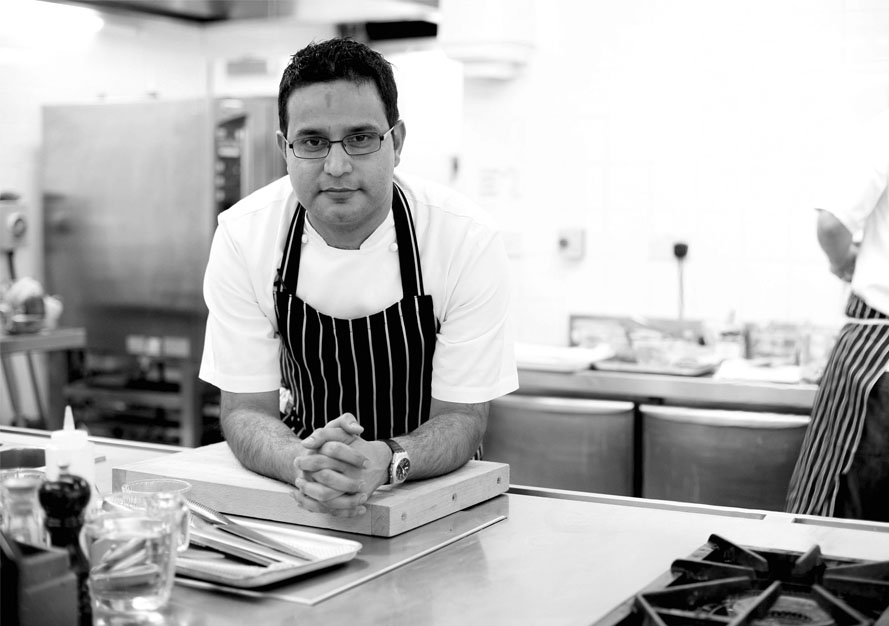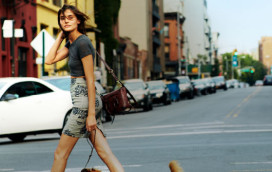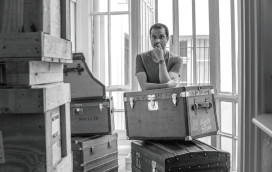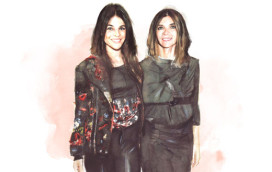The cavernous TriBeCa headquarters of the online fashion retailer Moda Operandi has all the urgency and buzz of an old-fashioned newsroom. Except that most newsrooms (or internet fashion companies for that matter) are not decorated by the society interior designer Daniel Romualdez, complete with a vintage bronze coffee table, floral upholstered Louis XVI-style chairs, and oversized custom linen lampshades hanging throughout the industrial space, which is painted in its very own hue, Moda Pink. Its founder, Lauren Santo Domingo, has the unruffled presence and gait of a swan. The blonde, lissom Santo Domingo, one of Vogue’s most photographed belles, is dressed in a Stella Jean printed cotton party dress, with fitted bodice and a full skirt, topped by an ecru Carven cropped sweater (worn backwards to perfect effect) and Lucite heels by Nicholas Kirkwood. This effortless mix personifies Moda Operandi’s savvy intent: to service its fashion-obsessed global clientele with outfits and combinations that they can’t find elsewhere and allow them to purchase them with a click.
The site itself is based on the idea of the traditional trunk show in which designers, such as James Galanos, Bill Blass and Carolina Herrera, would make personal appearances and cater to special clients, but in a modern high-tech way. “I once thought the trunk show was about to go the way of the fax machine,” says Santo Domingo. “But based on the success of our business, I’d say it’s back. In a big way.” Fashion designers, such as Bibhu Mohapatra (who has dressed Michelle Obama) and Barbara Tfank (Diablo Cody and Rita Ora are fans), and noted jewelers including Jade Jagger and Kara Ross, have all expanded the old-fashioned trunk show to cater to clients who want not just a more personal approach with the clothes, but with the designer. And the designers are not complaining. “It’s the backbone of my business,” says Cornelia Guest, whose cruelty-free line of handbags has found a thriving niche, thanks to private lunches in such cities as Houston and San Francisco hosted by the international society doyennes Lynn Wyatt and Denise Hale (friends of Cornelia’s late mother, the incomparable C. Z. Guest). “There’s no better entrée,” she says. “And, trust me: these women love to shop.” In the 1980s, women would flock to catch a glimpse of an Oscar de la Renta or Geoffrey Beene. Robert Burke, former senior vice-president of fashion at Bergdorf Goodman and now CEO of the consulting firm Robert Burke Associates, recalls how VIP clients would plunk down en masse an easy million dollars at a Chanel trunk show. “They were a serious part of the business,” he notes. This isn’t just about sales, though. Designers really enjoy this kind of interaction with their customers and getting personal feedback.
Michael Kors can’t resist working three or four dressing rooms at once; Donna Karan, who built her business on intimately knowing her clients and their body shapes, famously loved to jump inside and undress herself alongside the customer; and Dennis Basso took the term “trunk show” back to its roots, stocking the trunk of his car with his priceless furs and going from door-to-door in the New York suburbs. Both Zac Posen and Jason Wang credit more than a modicum of their success to knowing the needs of the women themselves. “It’s important,” says Wang. “I need to know what my clients are like; it puts my work into perspective. It’s really thrilling… The clients are really into the clothes. Last time I went to Nordstrom to do a trunk show, one woman bought 41 pieces.” Nor have designers lost sight of the importance of wooing deep-pocketed customers in the sky-rocketing markets of Asia and the Middle East with private events and behind-the-scenes tours that offer a more personal service than stores normally offer, including meeting designers themselves. Naeem Khan, Reem Acra, and Monique Lhuillier all court the Middle-Eastern customer. “They all want to get customer loyalty, especially in places like Qatar, Abu Dhabi and Russia,” says Burke. Matches, the London-based string of upscale boutiques, frequently hosts trunk shows and parties in an elegant townhouse set aside for entertaining and private shopping and also takes young British designers on road shows to the Middle East.
“The trunk show or personal appearance has evolved since it began,” adds Roopal Patel, a former fashion director of Neiman Marcus who now heads her own consulting firm. Why do they want them? “Customers are looking for special, exclusive products that they can’t find anywhere else and designs they can’t find just anywhere.” And no designer is taking them for granted. Take Mary Katrantzou, arguably one of today’s hottest designers, who has been out to Brazil and the US and is headed to Dubai and Singapore this autumn. “We didn’t really understand the power of the trunk show at first,” she says. “It is really important to build these relations with loyal customers and court them. And we were amazed at how much you can sell.” After Karolina Kurkova had dropped into a trunk show at the East Village jewelry showroom, Bijules, she knew where to go for something edgy for this year’s annual Metropolitan Museum of Art Costume Ball, which had a punk theme. She left with the perfect cocktail ring, a 14ct gold handlet and a two-piece knuckle-ring set. “No saleswoman can sell a piece of my jewelry like I can,” says the boutique’s owner Jules, whose clients include Rihanna, Beyoncé and Alicia Keys, and who recently traveled to Dallas for a personal trunk show. “These women don’t want to go into stores and be treated anonymously. They came in and dropped a ton of money.”
When Anne Hearst recently hosted a gathering for Jade Jagger in her Manhattan penthouse for girlfriends including Laurie Durning, the wife of Pink Floyd’s Roger Waters and her niece Gillian Hearst, the famed interior designer Milly de Cabrol recalls: “I only went because it was by invitation only, given by my friend and with Jade Jagger. That was what made it special.” After casually glancing at Jagger’s jewelry spread out on a coffee table, de Cabrol found herself departing with a ruby-heart gold ring. “Jade was absolutely charming and very down-to-earth. It does make you want to buy.” Jagger, who’s held trunk shows in Hong Kong, Bombay and New York, says: “The ladies tend to get more excited. They tend to go for the higher-end pieces, and it’s good to cut out the middle man. It just creates a great buzz.” After jeweler Lynn Ban’s friend, the Singapore fashionista Cindy Chua-Tay, tossed a trunk show there on her behalf, Ban, who’s already appeared at Lane Crawford in Hong Kong, says: “Now I’m in [the chic Singapore boutique] Club 21”, where she recently sold a $20,000 black diamond gash cuff. “Word of mouth is very effective,” says Jane Pendry of Dovima Paris (“the Tory Burch of Europe”) whose trunk shows in Paris and around the US are by appointment, and where she personally tailors individual ensembles. “You get influencers in fashion from all over the world,” says the New York-based Jennifer Creel, whose eco-friendly sunglasses have been relished at homey trunk shows in London, and who now finds her across-the-pond girlfriends Pia Getty and Marie-Chantal of Greece, among others, spreading the gospel from St. Barths to the Cote d’Azur. The New York jeweler and handbag designer Kara Ross has found herself hosting trunk shows in Jeddah and Al Khabar in Saudi Arabia for a bevy of princesses who might be swathed in an abaya, but nevertheless cherish her diamond ostrich Electra bag. While Sally Perrin of Perrin Paris 1893 hosts Qataris and Saudis who pass through Paris in her Left Bank apartment. “Have trunk show, will travel, is our motto,” she says triumphantly.
According to the Vanity Fair fashion expert and special correspondent Amy Fine Collins, the trunk show of today is “a sensory, migratory experience”. Moda Operandi’s VIP clients are now traveling to TriBeCa to its Salon Moda, with its fabric-painted trompe l’oeil, striped silk drapes, and divine clothing, including a Wes Gordon ink petit swan print sable and lace inset dress and a Nina Ricci long fringe and lace dress in rose crystal. All at the ready for the client who, as Santo Domingo points out, “can have anything in the world her heart desires, but, ironically, could never get her hands on the dresses and looks she wanted”. Stylists who’ve traveled to Abu Dhabi and Bahrain to deliver Marquesa and Giles gowns for a fashion emergency, are at the ready. “You feel like you’re getting something nobody else is,” says Brittany Weeden, who ended up spending $8,000 on her most recent visit. “It’s like, ‘Oh my gosh, I have to have that.’ And once I found out that the salon is a replica of Lauren Santo Domingo’s closet, well, I felt very special.”
Images by Maciek Kobielski/Art Partner, Xavi Menos, Getty







